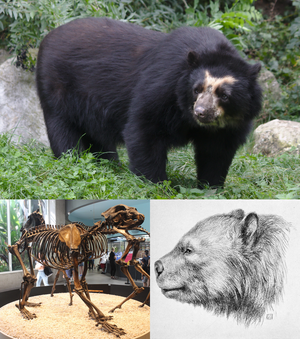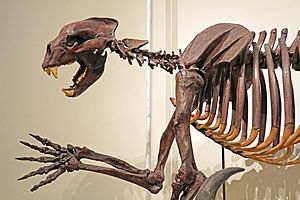Tremarctinae facts for kids
Quick facts for kids Tremarctinae |
|
|---|---|
 |
|
| Spectacled bear, Arctodus simus and Arctotherium bonariense | |
| Scientific classification |
|
| Kingdom: | Animalia |
| Phylum: | Chordata |
| Class: | Mammalia |
| Order: | Carnivora |
| Family: | Ursidae |
| Subfamily: | Tremarctinae Merriam & Stock, 1925 |
| Genera | |
|
†Plionarctos |
|
The Tremarctinae, also known as short-faced bears, are a group of bears. Today, only one type of short-faced bear is still alive: the spectacled bear (Tremarctos ornatus), which lives in South America.
But long ago, there were many other kinds of short-faced bears! These included the Florida spectacled bear and two types of giant short-faced bears: Arctodus from North America and Arctotherium from South America. There was also an older bear called Plionarctos, which scientists think was the ancestor of the other short-faced bears.
Some of these giant short-faced bears, like Arctodus simus and Arctotherium angustidens, might have been the biggest meat-eating mammals ever in the Americas. Scientists believe these bears first appeared in eastern North America. Later, they moved into South America during a time called the Great American Interchange, when many animals traveled between the two continents. Most short-faced bears died out at the end of the Pleistocene Ice Age.
Contents
How Short-Faced Bears Evolved
The story of short-faced bears begins with their earliest ancestor, Plionarctos. This bear lived in North America about 10 million years ago. The last records of Plionarctos are from about 3.3 million years ago.
Around 5 million years ago, many different types of bears, including the short-faced bears, started to appear very quickly. This happened when the world's climate changed a lot. It got colder, and there were more open grasslands. Many animals in Europe and North America died out during this time.
Scientists have studied the DNA of these bears to figure out when they split into different groups. They think that Arctotherium, Arctodus, and Tremarctos all started to become separate groups around 4.8 million years ago. The first signs of all three groups are found in North America.
Later, short-faced bears started to spread out. An early Arctotherium bear was found in El Salvador in Central America. During the Early Pleistocene period, short-faced bears became more common in both North and South America. The medium-sized Arctodus pristinus lived across North America, while the Tremarctos floridanus lived only along the Gulf Coast.
The first Arctotherium bears in South America were the huge Arctotherium angustidens. These giant bears appeared in Argentina about 1 million years ago and might have been the largest meat-eating land mammals ever!
In the Middle Pleistocene, new types of Arctodus and Arctotherium appeared. Arctodus pristinus was replaced by the even bigger Arctodus simus. This huge bear lived all over North America, from Alaska to Mexico. In South America, Arctotherium angustidens was replaced by smaller species like Arctotherium vetustum, Arctotherium bonariense, and Arctotherium tarijense.
By the end of the Pleistocene, Arctodus simus, Tremarctos floridanus, Arctotherium tarijense, and Arctotherium wingei lived across a huge area, from Alaska all the way to southern Patagonia. But all these bears died out by the beginning of the Holocene period. Around this time, the spectacled bear (Tremarctos ornatus) started to appear in the fossil record in South America.
What Did Short-Faced Bears Look Like?
Short-faced bears seem to have shorter snouts (noses and mouths) compared to most modern bears. This is why they are called "short-faced." However, their faces were actually deeper, not necessarily shorter, than other bears. Their deep snouts and short nasal bones made them look different.
Scientists can also tell short-faced bears apart from other bears by looking at their bones. For example, they had an extra bump on one of their molars (back teeth). Their skulls were also deeper and rounder, and they had strong jaw muscles. Their eye sockets were bigger and rounder too, and pointed more to the sides.
How Short-Faced Bears Lived
Short-faced bears lived in many different ways. Some were smaller and mostly ate plants, like Arctotherium wingei and the living spectacled bear. These bears probably lived in forests.
But then there were the giant ones, like Arctotherium angustidens and Arctodus simus. These huge bears were omnivores, meaning they ate both plants and meat, but they really loved to eat a lot of meat! They lived in open plains.
Even though the two giant species looked similar, they had important differences. Arctodus simus lived across North America for 800,000 years. But Arctotherium angustidens seemed to live only in the southern part of South America.
Scientists have studied the diets of these bears. Arctodus simus ate different amounts of meat depending on where it lived. For example, bears in Alaska ate more meat. But Arctotherium angustidens seemed to eat a similar amount of meat no matter where it lived.
Scientists are still trying to understand why Arctodus was more lightly built, while Arctotherium angustidens was very strong and heavy. One idea is that when other large meat-eating animals that ate dead animals (scavengers) died out, it opened up a chance for Arctodus and Arctotherium to grow very large.
Arctodus and Tremarctos also have features that are common in bears that eat a lot of plants. These include large cheek teeth and strong jaws. Bears that eat plants need strong jaws to chew their food a lot, because their bodies aren't very good at digesting plant matter. This suggests that eating plants might have been a common trait for the early short-faced bears.
Family Tree of Short-Faced Bears
| Tremarctinae within Ursidae | |||||||||||||||||||||||||||||||||||||||||||||||||||
|
Scientists used to think that Plionarctos and Tremarctos were older, more basic groups, and that Arctodus and Arctotherium were more closely related to each other.
However, a newer study showed that Arctotherium bears are actually more closely related to the spectacled bear (Tremarctos) than to Arctodus. This means that the giant size seen in Arctodus and Arctotherium might have developed separately in each group, rather than coming from a single giant ancestor.
Sometimes, in older science books, short-faced bears were called arctodonts or arctotheres. But these names are not used much anymore.
Types of Short-Faced Bears
Here is a list of the different types of short-faced bears, according to scientists:
- Subfamily Tremarctinae
- †Plionarctos
- †Plionarctos harroldorum
- †Plionarctos edensis
- †Arctodus
- †Arctodus simus
- †Arctodus pristinus
- †Arctotherium
- †Arctotherium angustidens
- †Arctotherium vetustum
- †Arctotherium wingei
- †Arctotherium bonariense
- †Arctotherium tarijense
- Tremarctos
- †Tremarctos floridanus
- Tremarctos ornatus – the spectacled bear
- †Plionarctos
See also
 In Spanish: Tremarctinos para niños
In Spanish: Tremarctinos para niños
- Pleistocene megafauna (Giant animals of the Ice Age)
- Pleistocene extinctions (When many animals died out at the end of the Ice Age)


